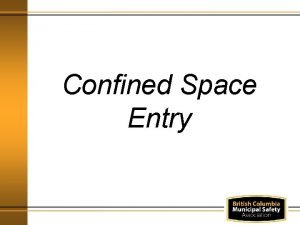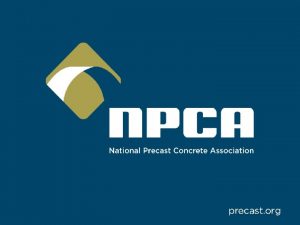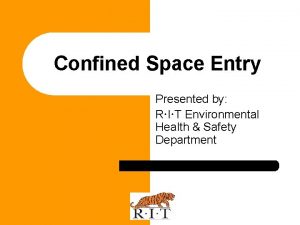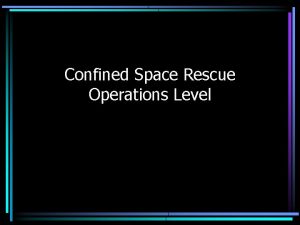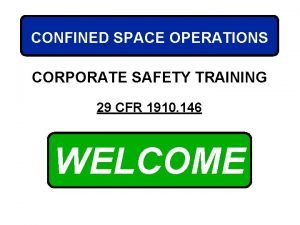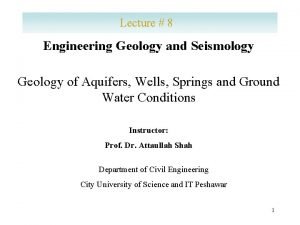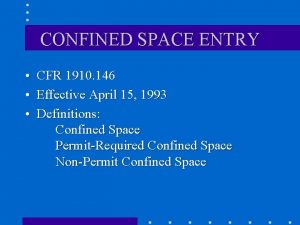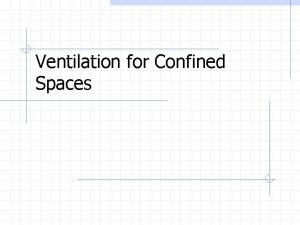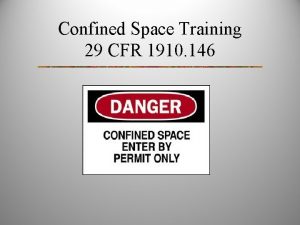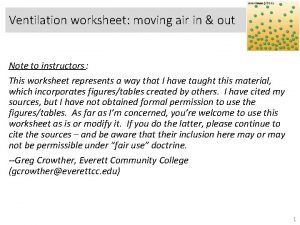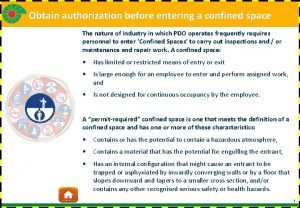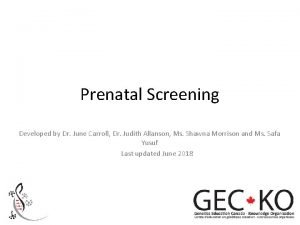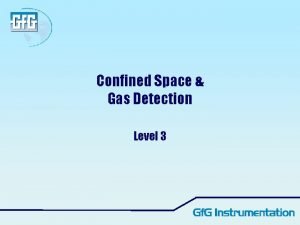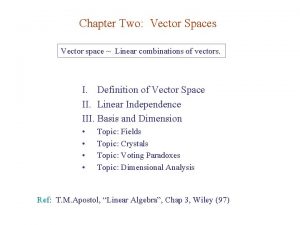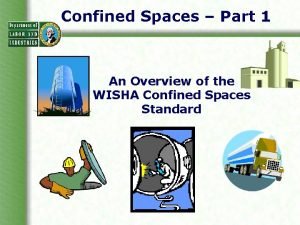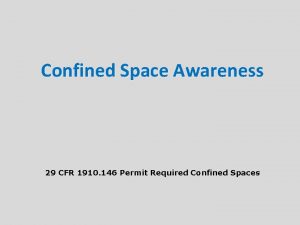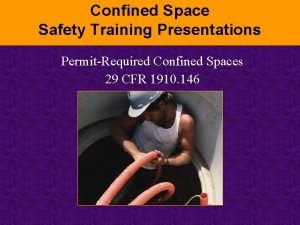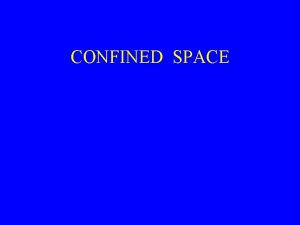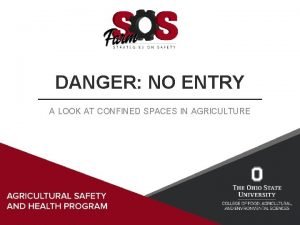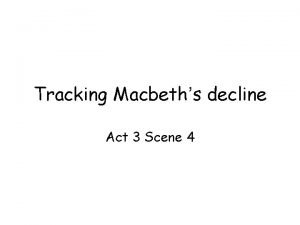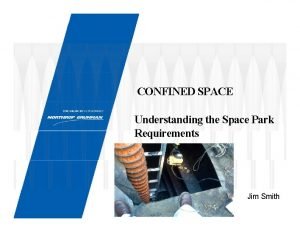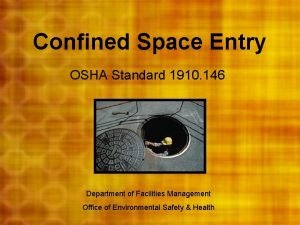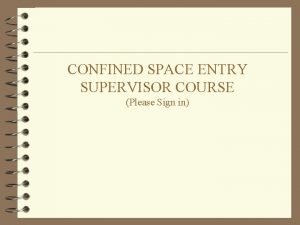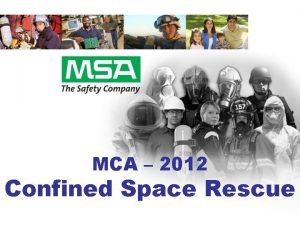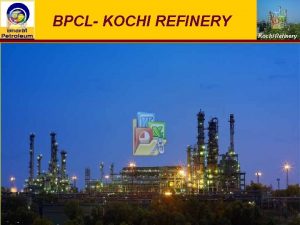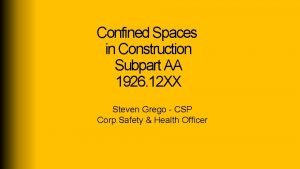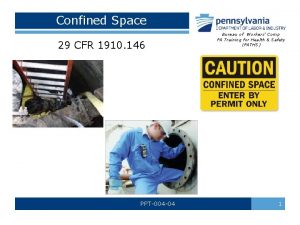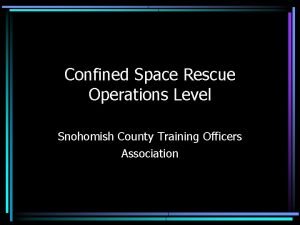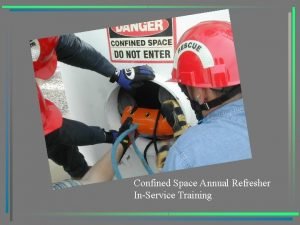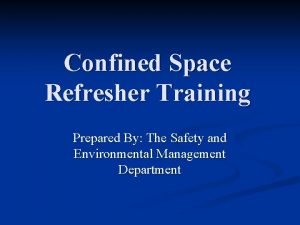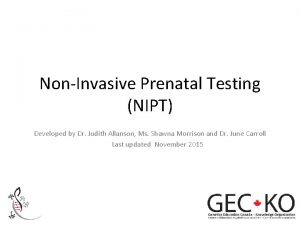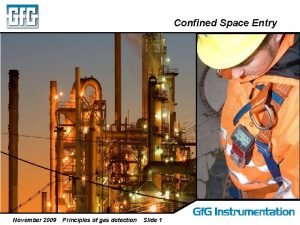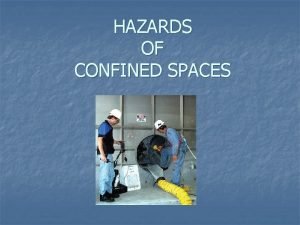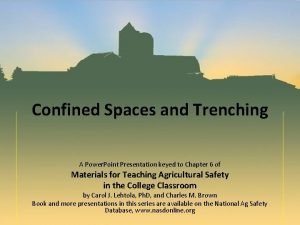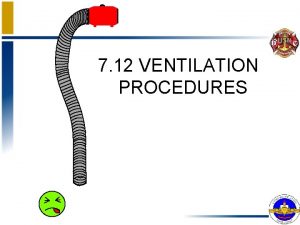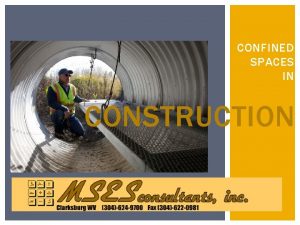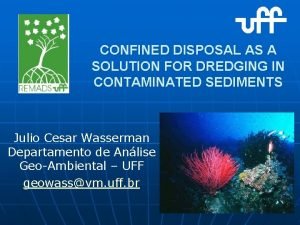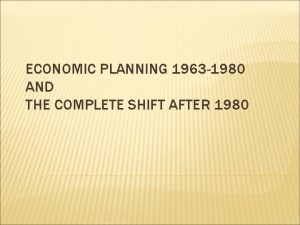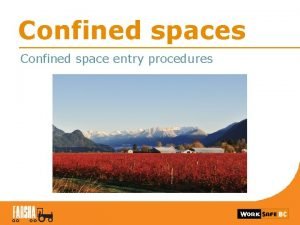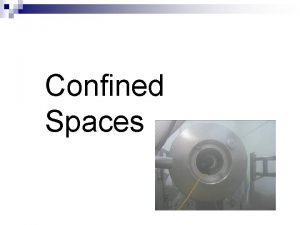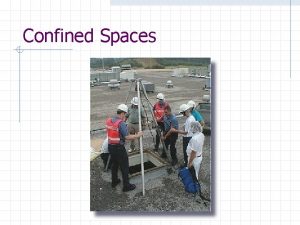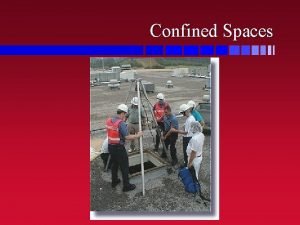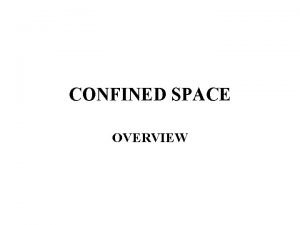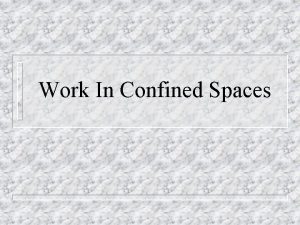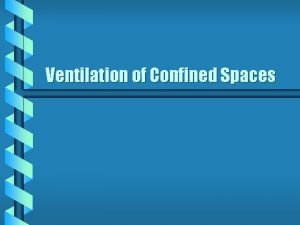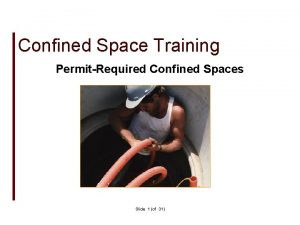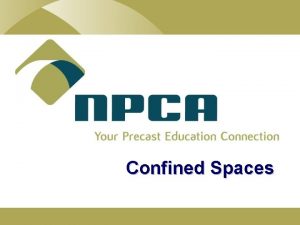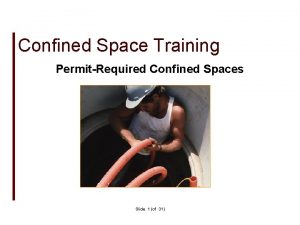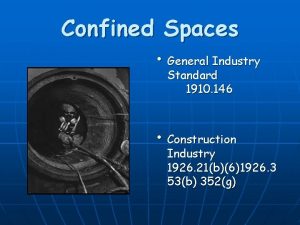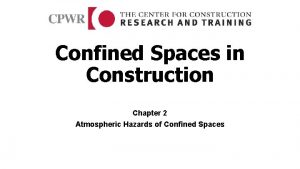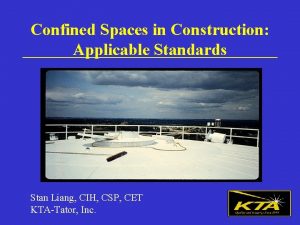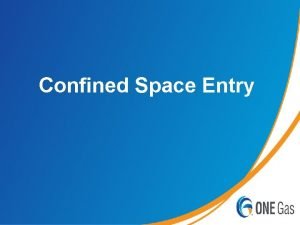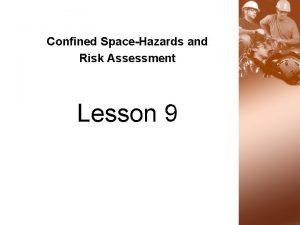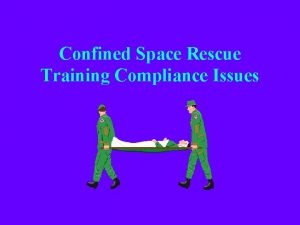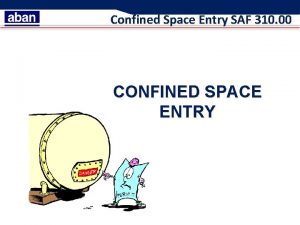CONFINED SPACES IN CONSTRUCTION CONSTRUCTION CONFINED SPACES 1980








































- Slides: 40

CONFINED SPACES IN CONSTRUCTION

CONSTRUCTION & CONFINED SPACES 1980 - first ANPR for confined spaces in construction 1993 - confined spaces in general industry 2007 - confined spaces in construction Final Rule- May 4, 2015 Effective date- August 3, 2015 Temporary Enforcement Policy- OSHA will not issue citations to employers making good faith efforts to comply until after October 2, 2015 (training of employees needed to be addressed).

CONFINED SPACE IN CONSTRUCTION (29 CFR 1 9 2 6. 12 0 0 -12 1 3 ) What is a confined space? Is my company performing construction work or general industry work?

WHAT IS A CONFINED SPACE? (1910 vs 1926)

WHAT IS A CONFINED SPACE? OSHA DEFINITIONS (1910. 146) 29 CFR 1910. 146(b) "Confined space" means a space that: § (1) Is large enough and so configured that an employee can bodily enter and perform assigned work; and § (2) Has limited or restricted means for entry or exit; and § (3) Is not designed for continuous employee occupancy. 29 CFR 1926. 1202 "Confined space" means a space that: § (1 ) Is large enough and so configured that an employee can bodily enter it; and § (2) Has limited or restricted means for entry or exit; and § (3) Is not designed for continuous employee occupancy.

THREE TYPES OF CONFINED SPACES Permit Required PRCS Non. Permit Required Confined Space Alternate Procedure

PERMIT REQUIRED CONFINED SPACE A confined space that has one or more of the following characteristics is a PRCS: (1) Contains or has a potential to contain a hazardous atmosphere; (2) Contains a material that has the potential for engulfing an entrant; (3) Has an internal configuration such that an entrant could be trapped or asphyxiated by inwardly converging walls or by a floor which slopes downward and tapers to a smaller cross-section; or (4) Contains any other recognized serious safety or health hazard.

NON-PERMIT REQUIRED CONFINED SPACE A confined space that does not contain or, with respect to atmospheric hazards, have the potential to contain any hazard capable of causing death or serious physical harm.

ALTERNATE PROCEDURE Permit required space wherein hazards are atmospheric only and controlled through continuous forced air ventilation.

Are these Confined Spaces? YES (1) Is large enough and so configured that an employee can bodily enter and perform assigned work; and (2) Has limited or restricted means for entry or exit; and (3) Is not designed for continuous employee occupancy.

Examples of Confined Spaces 1926 Sub. Part AA bins boilers pits (such as elevator, escalator, pump, valve or other equipment) manholes tanks (such as fuel, chemical, water, or other liquid, solid or gas) incinerators scrubbers concrete pier columns sewers transformer vaults heating vent/HVAC storm drains water mains precast concrete other pre-formed manhole units drilled shafts enclosed beams vessels digesters lift stations cesspools silos air receivers sludge gates air preheaters step up transformers turbines chillers bag houses and/or mixers/reactors. § OSHA. GOV

CONFINED SPACE STANDARDS GENERAL INDUSTRY OR CONSTRUCTION

CONSTRUCTION WORK (29 CFR 1910. 12(b) construction Construction Work alteration repair

LETTER OF INTERPRETATION 11/18/2003 – Clarification of maintenance vs. construction activities, This letter of interruption states that “Construction work is not limited to new construction, but can include the repair of existing facilities or the replacement of structures and their components. For example, the replacement of one utility pole with a new, identical pole would be maintenance; however, if it were replaced with an improved pole or equipment, it would be considered construction. ”

LETTER OF INTERPRETATION 02/01/1999 – The difference between maintenance and construction, and This letter of interruption defines maintenance as “… keeping equipment or a structure in proper condition through routine, scheduled or anticipated measures without having to significantly alter the structure or equipment in the process. For equipment, this generally means keeping the equipment working properly by taking steps to prevent its failure or degradation. ”

Let’s assume these are all construction activities. Is 1926 Sub. Part AA Applicable? NOT NECESSARILY EXEMPTIONS: subpart P (Excavations) subpart S (Underground Construction, Caissons, Cofferdams and Compressed Air) subpart Y (Diving)

WHAT ARE THE MAJOR DIFFERENCES BETWEEN THESE CONFINED SPACE STANDARDS?

SIDE BY SIDE TABLE OF CONTENTS Paragraph 29 CFR 1910. 146 Section 29 CFR 1926 Sub. Part AA A Scope and Application Exemptions: 1926, 1928, 1915 1201 Scope Exemptions: Subparts P, S, Y B Definitions 1202 Definitions C General Requirements 1203 General Requirements D Permit-required confined space program 1204 Permit-required confined space program E Permit system 1205 Permitting process F Entry permit 1206 Entry permit G Training 1207 Training H Duties of authorized entrants 1208 Duties of authorized entrants I Duties of attendants 1209 Duties of attendants J Duties of entry supervisors 1210 Duties of entry supervisors K Rescue and emergency services 1211 Rescue and emergency services L Employee participation 1212 Employee participation 1213 Provisions of documents to Secretary

NEW TO CONFINED SPACE REGULATIONS (INCLUDED IN 1926 SUBPART AA BUT NOT IN 1910. 146) § Definitions § Multiple employers at the worksite/Competent person § Continuous atmospheric monitoring § Continuous monitoring of engulfment hazards § Allowing for the suspension of a permit § Provisions that clarify existing requirements in the General Industry standard.

DEFINITIONS

DEFINITIONS UNIQUE TO 29 CFR 1926 SUBPART AA Barrier, Competent person, Controlling Contractor, Early-warning system, Entry Employer, Entry rescue, Hazard, Host Employer, Limited or Restricted entry, Lockout, Lower flammable limit or lower Explosive limit, Monitor or monitoring, Non-entry rescue, Physical hazard, Qualified person, Representative permit space, Rescue, Serious physical damage, Tagout, and Ventilate or ventilation.

DEFINITIONS (EMPLOYER) Host Employer means the employer that owns or manages the property where the construction work is taking place. Controlling Contractor is the employer that has overall responsibility for construction at the worksite. Entry Employer means any employer who decides that an employee it directs will enter a permit space. § Note to the definition of "Entry Employer“ An employer cannot avoid the duties of the standard merely by refusing to decide whether its employees will enter a permit space, and OSHA will consider the failure to so decide to be an implicit decision to allow employees to enter those spaces if they are working in the proximity of the space.

DEFINITIONS (EMPLOYER) Entry Supervisor means the qualified person (such as the employer, foreman, or crew chief) responsible for determining if acceptable entry conditions are present at a permit space where entry is planned, for authorizing entry and overseeing entry operations, and for terminating entry as required by this standard. Competent person means one who is capable of identifying existing and predictable hazards in the surroundings or working conditions which are unsanitary, hazardous, or dangerous to employees, and who has the authorization to take prompt corrective measures to eliminate them. Qualified person means one who, by possession of a recognized degree, certificate, or professional standing, or who by extensive knowledge, training, and experience, has successfully demonstrated his ability to solve or resolve problems relating to the subject matter, the work, or the project.

DEFINITIONS (HAZARDS) Hazard means a physical hazard or hazardous atmosphere. Physical hazard means an existing or potential hazard that can cause death or serious physical damage. § § § § § explosives mechanical electrical hydraulic and pneumatic energy radiation temperature extremes engulfment noise inwardly converging surfaces.

DEFINITIONS (CONTROLS) Control means the action taken to reduce the level of any hazard inside a confined space using engineering methods. Personal protective equipment is not a control. Early-warning system means the method used to alert authorized entrants and attendants that an engulfment hazard may be developing. § Alarms activated by remote sensors; and lookouts with equipment for immediately communicating with the authorized entrants and attendants.

DEFINITIONS (CONTROLS) Lockout means the placement of a lockout device on an energy isolating device, in accordance with an established procedure, ensuring that the energy isolating device and the equipment being controlled cannot be operated until the lockout device is removed Tagout means placement of a tagout device on a circuit or equipment that has been deenergized, in accordance with an established procedure, to indicate that the circuit or equipment being controlled may not be operated until the tagout device is removed; Ventilate or ventilation means controlling a hazardous atmosphere using continuous forced-air mechanical systems that meet the requirements of § 1926. 57 (Ventilation).

DEFINITIONS Entry Rescue occurs when a rescue service enters a permit space to rescue one or more employees. Limited or restricted means for entry or exit means a condition that has a potential to impede an employee's movement into or out of a confined space. Such conditions include, but are not limited to, trip hazards, poor illumination, slippery floors, inclining surfaces and ladders. Lower flammable limit or lower explosive limit means the minimum concentration of a substance in air needed for an ignition source to cause a flame or explosion. Monitor or monitoring means the process used to identify and evaluate the hazards after an authorized entrant enters the space. This is a process of checking for changes that is performed in a periodic or continuous manner after the completion of the initial testing or evaluation of that space.

MULTIPLE EMPLOYERS AT THE WORKSITE/ COMPETENT PERSON

MULTIPLE EMPLOYERS AT THE WORKSITE Host employer must provide confined space information to Controlling Contractor is the primary point of contact for information about permit spaces at the work site. § Duties: § Share information about hazards with entry employers and other employers who may contribute to hazards § Coordinate entry operations when there is more than one entry employer § Coordinate operations when PRCS entry occurs during other activities at the site that might create a hazard in the space. Entry Employers must share entry program information with Controlling Contractors. § Duties: § Protect workers against permit space hazards by complying with the standard. § Inform controlling contractor of the program followed and hazards encountered in permit spaces.

MULTIPLE EMPLOYERS AT THE WORKSITE

COMPETENT PERSON Required to evaluate the work site and identify confined spaces, including permit spaces. § 1926. 32(f) "Competent person" means one who is capable of identifying existing and predictable hazards in the surroundings or working conditions which are unsanitary, hazardous, or dangerous to employees, and who has authorization to take prompt corrective measures to eliminate them.

CONTINUOUS ATMOSPHERIC MONITORING

CONTINUOUS ATMOSPHERIC MONITORING Requiring continuous atmospheric monitoring whenever possible. 1910. 146 (c)(5)(ii)(f) 1926. 1203 (e)(2)(vi) The atmosphere within the space shall be periodically tested as necessary to ensure that the continuous forced air ventilation is preventing the accumulation of a hazardous atmosphere…. . The atmosphere within the space must be continuously monitored unless the entry employer can demonstrate that equipment for continuous monitoring is not commercially available or periodic monitoring is sufficient. If continuous monitoring is used, the employer must ensure that the monitoring equipment has an alarm that will notify all entrants if a specified atmospheric threshold is achieved, or that an employee will check the monitor with sufficient frequency to ensure that entrants have adequate time to escape.

CONTINUOUS MONITORING OF ENGULFMENT HAZARDS Requiring continuous monitoring of engulfment hazards. § For example, when workers are performing work in a storm sewer, a storm upstream from the workers could cause flash flooding. An electronic sensor or observer posted upstream from the work site could alert workers in the space at the first sign of the hazard, giving the workers time to evacuate the space safely.

ALLOWING FOR THE SUSPENSION OF PERMIT

SUSPENSION OF PERMIT Allowing for the suspension of a permit, instead of cancellation, in the event of changes from the entry conditions list on the permit or an unexpected event requiring evacuation of the space. The space must be returned to the entry conditions listed on the permit before re-entry. 1926. 1205(e) The entry supervisor must terminate entry and take the following action when any of the following apply: 1926. 1205(e)(2)Suspend or cancel the entry permit and fully reassess the space before allowing reentry when a condition that is not allowed under the entry permit arises in or near the permit space and that condition is temporary in nature and does not change the configuration of the space or create any new hazards within it…

PROVISIONS THAT CLARIFY EXISTING REQUIREMENTS IN THE GENERAL INDUSTRY STANDARD. Requiring that employers who direct workers to enter a space without using a complete permit system prevent workers’ exposure to physical hazards through elimination of the hazard or isolation methods such as lockout/tagout. Requiring that employers who are relying on local emergency services for emergency services arrange for responders to give the employer advance notice if they will be unable to respond for a period of time (because they are responding to another emergency, attending department-wide training, etc. ). Requiring employers to provide training in a language and vocabulary that the worker understands.

WHAT WILL THIS REGULATION DO?

PREVENTION Prevent approximately 780 serious injuries/year

THANK YOU- QUESTIONS OR COMMENTS
 Confined spaces
Confined spaces Confined spaces
Confined spaces Confined spaces
Confined spaces Saba confined space
Saba confined space Confined space classification
Confined space classification Confined space rescue equipment
Confined space rescue equipment Unconfined aquifer definition
Unconfined aquifer definition 1910-146
1910-146 1910 confined space
1910 confined space 29cfr1910.146
29cfr1910.146 Ventilation worksheet
Ventilation worksheet Obtain authorization before entering a confined space
Obtain authorization before entering a confined space Confined placental mosaicism
Confined placental mosaicism Confined space gas limits
Confined space gas limits Grim synoynm
Grim synoynm How to determine subspace of vector space
How to determine subspace of vector space Confined space gas limits
Confined space gas limits 1910 146
1910 146 Confined space training presentation
Confined space training presentation Confined space quiz
Confined space quiz Agricultural confined space training
Agricultural confined space training Act 3 scene 4 macbeth summary
Act 3 scene 4 macbeth summary Confined space rescue equipment
Confined space rescue equipment 1910 146
1910 146 Entry supervisor
Entry supervisor Confined space rescue equipment
Confined space rescue equipment Confined space rescue equipment
Confined space rescue equipment 1926 subpart aa
1926 subpart aa Confined space training ppt
Confined space training ppt Saba confined space
Saba confined space Confined space refresher training
Confined space refresher training Confined space refresher training
Confined space refresher training Sips vs nipt
Sips vs nipt Uel and lel
Uel and lel Confined space definition bc
Confined space definition bc Confined space powerpoint
Confined space powerpoint Ventilation calculation formula for confined space
Ventilation calculation formula for confined space Confined space meaning
Confined space meaning Suspended particulate matter
Suspended particulate matter 1980-1963
1980-1963 Ginebra 1980
Ginebra 1980
